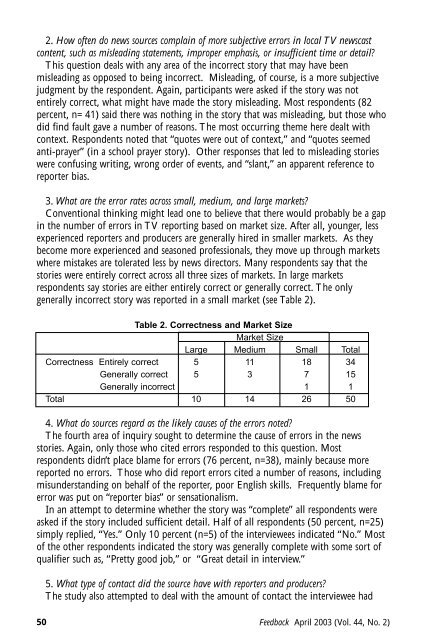APRILFeedback
Feedback April 2003 (Vol. 44, No. 2) - Broadcast Education ...
Feedback April 2003 (Vol. 44, No. 2) - Broadcast Education ...
- No tags were found...
You also want an ePaper? Increase the reach of your titles
YUMPU automatically turns print PDFs into web optimized ePapers that Google loves.
2. How often do news sources complain of more subjective errors in local TV newscastcontent, such as misleading statements, improper emphasis, or insufficient time or detail?This question deals with any area of the incorrect story that may have beenmisleading as opposed to being incorrect. Misleading, of course, is a more subjectivejudgment by the respondent. Again, participants were asked if the story was notentirely correct, what might have made the story misleading. Most respondents (82percent, n= 41) said there was nothing in the story that was misleading, but those whodid find fault gave a number of reasons. The most occurring theme here dealt withcontext. Respondents noted that “quotes were out of context,” and “quotes seemedanti-prayer” (in a school prayer story). Other responses that led to misleading storieswere confusing writing, wrong order of events, and “slant,” an apparent reference toreporter bias.3. What are the error rates across small, medium, and large markets?Conventional thinking might lead one to believe that there would probably be a gapin the number of errors in TV reporting based on market size. After all, younger, lessexperienced reporters and producers are generally hired in smaller markets. As theybecome more experienced and seasoned professionals, they move up through marketswhere mistakes are tolerated less by news directors. Many respondents say that thestories were entirely correct across all three sizes of markets. In large marketsrespondents say stories are either entirely correct or generally correct. The onlygenerally incorrect story was reported in a small market (see Table 2).Table 2. Correctness and Market SizeMarket SizeLarge Medium Small TotalCorrectness Entirely correct 5 11 18 34Generally correct 5 3 7 15Generally incorrect 1 1Total 10 14 26 504. What do sources regard as the likely causes of the errors noted?The fourth area of inquiry sought to determine the cause of errors in the newsstories. Again, only those who cited errors responded to this question. Mostrespondents didn’t place blame for errors (76 percent, n=38), mainly because morereported no errors. Those who did report errors cited a number of reasons, includingmisunderstanding on behalf of the reporter, poor English skills. Frequently blame forerror was put on “reporter bias” or sensationalism.In an attempt to determine whether the story was “complete” all respondents wereasked if the story included sufficient detail. Half of all respondents (50 percent, n=25)simply replied, “Yes.” Only 10 percent (n=5) of the interviewees indicated “No.” Mostof the other respondents indicated the story was generally complete with some sort ofqualifier such as, “Pretty good job,” or “Great detail in interview.”5. What type of contact did the source have with reporters and producers?The study also attempted to deal with the amount of contact the interviewee had50Feedback April 2003 (Vol. 44, No. 2)
















